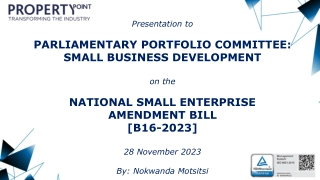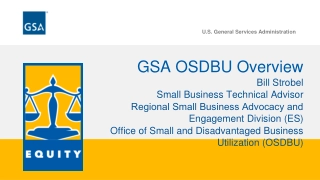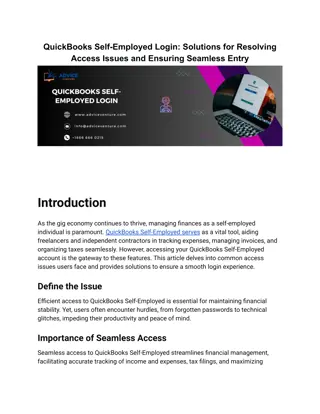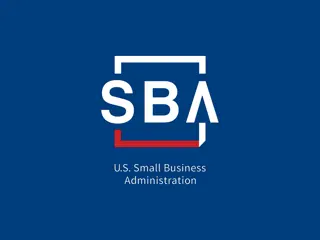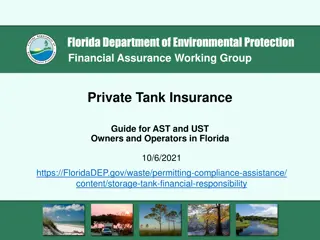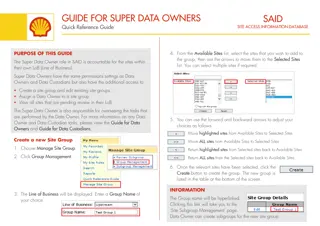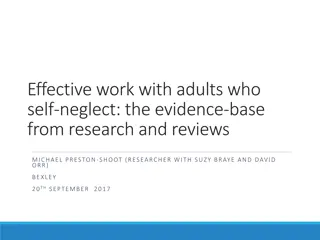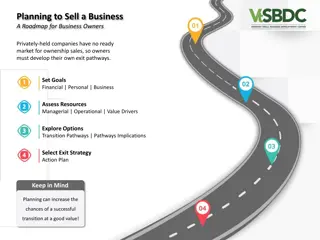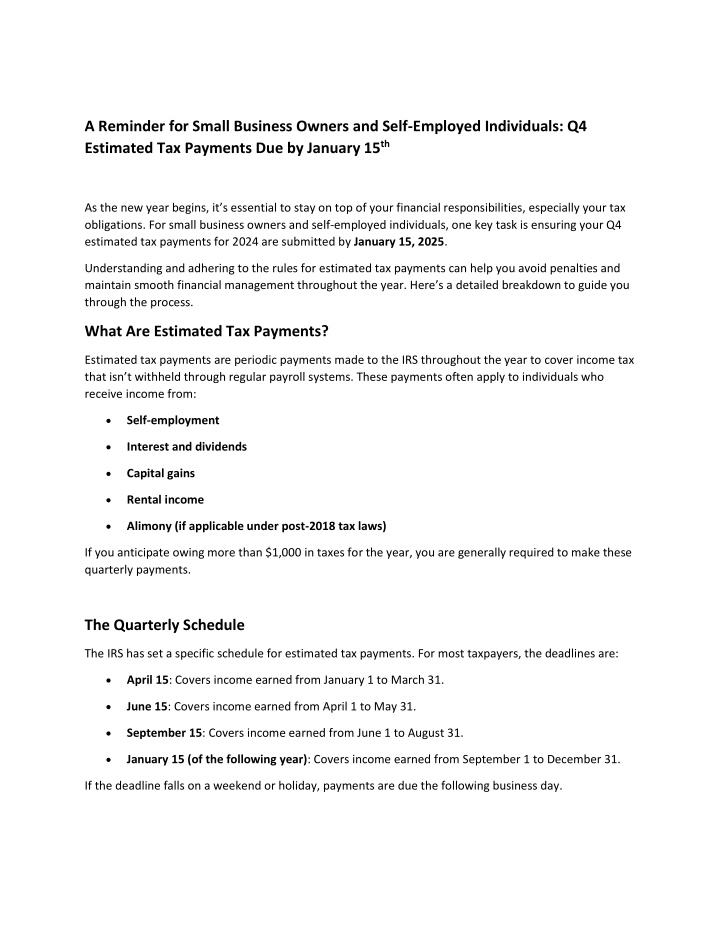
A Reminder for Small Business Owners and Self-Employed Individuals
As the new year begins, itu2019s essential to stay on top of your financial responsibilities, especially your tax obligations. For small business owners and self-employed individuals, one key task is ensuring your Q4 estimated tax payments for 2024
Uploaded on | 9 Views
Download Presentation

Please find below an Image/Link to download the presentation.
The content on the website is provided AS IS for your information and personal use only. It may not be sold, licensed, or shared on other websites without obtaining consent from the author. If you encounter any issues during the download, it is possible that the publisher has removed the file from their server.
You are allowed to download the files provided on this website for personal or commercial use, subject to the condition that they are used lawfully. All files are the property of their respective owners.
The content on the website is provided AS IS for your information and personal use only. It may not be sold, licensed, or shared on other websites without obtaining consent from the author.
E N D
Presentation Transcript
A Reminder for Small Business Owners and Self-Employed Individuals: Q4 Estimated Tax Payments Due by January 15th As the new year begins, it s essential to stay on top of your financial responsibilities, especially your tax obligations. For small business owners and self-employed individuals, one key task is ensuring your Q4 estimated tax payments for 2024 are submitted by January 15, 2025. Understanding and adhering to the rules for estimated tax payments can help you avoid penalties and maintain smooth financial management throughout the year. Here s a detailed breakdown to guide you through the process. What Are Estimated Tax Payments? Estimated tax payments are periodic payments made to the IRS throughout the year to cover income tax that isn t withheld through regular payroll systems. These payments often apply to individuals who receive income from: Self-employment Interest and dividends Capital gains Rental income Alimony (if applicable under post-2018 tax laws) If you anticipate owing more than $1,000 in taxes for the year, you are generally required to make these quarterly payments. The Quarterly Schedule The IRS has set a specific schedule for estimated tax payments. For most taxpayers, the deadlines are: April 15: Covers income earned from January 1 to March 31. June 15: Covers income earned from April 1 to May 31. September 15: Covers income earned from June 1 to August 31. January 15 (of the following year): Covers income earned from September 1 to December 31. If the deadline falls on a weekend or holiday, payments are due the following business day.
Calculating Your Payments To calculate your estimated tax payments, use Form 1040-ES. The form includes a worksheet that can help you: 1.Estimate your total income for the year. 2.Determine your deductions and credits. 3.Calculate your expected tax liability. 4.Divide your total estimated tax liability into four equal installments. Alternatively, you can pay based on your prior year s tax liability to simplify the process: Pay 100% of last year s tax liability (or 110% if your adjusted gross income (AGI) exceeds $150,000). Pay 90% of your current year s estimated tax liability to avoid penalties. How to Make Your Payments There are multiple ways to make estimated tax payments: 1.Online:Use the IRS s secure payment portal at IRS.gov/payments. 2.By Phone: The IRS offers phone payment options for quick and secure transactions. 3.Traditional Methods:Send a check or money order payable to United States Treasury along with a completed payment voucher from Form 1040-ES. Remember to keep records of all payments for your financial and tax files. Avoiding Penalties Failure to make adequate estimated tax payments can result in penalties. To avoid this, ensure you meet one of the following criteria: Pay at least 90% of your current year s tax liability. Pay 100% of your prior year s tax liability (or 110% if your AGI exceeds $150,000). Additionally, if you live in New Jersey, note that extensions require at least 80% of your tax liability to be paid by the original due date to maintain eligibility for an extension. Life Changes and Their Impact on Taxes Significant life events can impact your tax situation, such as:
Changes in marital status The birth or adoption of a child Starting or closing a business Be proactive in reassessing your tax obligations when these events occur. Adjusting your estimated tax payments accordingly can help prevent unexpected liabilities. We re Here to Help Navigating tax requirements can be challenging, but you don t have to do it alone. Our team of tax professionals is here to assist you with: Calculating your estimated tax payments Understanding your tax liability Ensuring compliance with IRS rules Stay ahead of your financial responsibilities and avoid unnecessary stress as the tax season approaches. Contact us today for personalized guidance and support. By staying informed and proactive, you can manage your estimated tax payments efficiently and keep your financial year on track. Don t wait until the last minute submit your Q4 payment by January 15, 2025.

